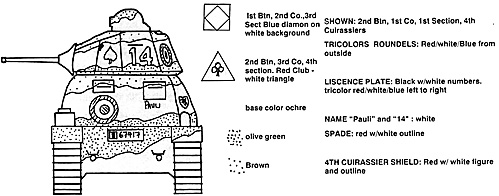
1939 - 1940
French armored fighting vehicles (AFV's) during the 1930's were painted a basic olive green overall. During the late 30's, multicolored camouflage came back into vogue, and ochre and chestnut brown were applied to break up vehicle outlines. Black was often used to outline either of these colors. Multicolor schemes were normally factory-app lied, but occasionally, with vehicles already in service, crews applied their own camouflage using these colors. A wide range of patterns and color combinations were used, normally applied in irregular bands: green overall, green and ochre, green, ochre, and brown, green and ochre outlined in black, green and brown outlined in ochre, and all three colors outlined in black. In 1940, units were told to repaint their vehicles in olive green or army grey. Most didn't, but new factory supplied vehicles so painted were usually left green or grey. Numerous vehicle types carried camouflage unique to the type. I commend the reader to Steve Zaloga (#13 in the bibliography) for full details of these patterns, as well as a fuller explanation of French camouflage in general.
On the gaming table, this is what makes French tanks so distinctive. If you do nothing else to your French armor, camouflage it. It's a pleasant change from all those other monotone AFV's, and very few gamers will know enough about it to challenge you on accuracy!
French armor carried a small national tricolor and a vehicle number (normally in white) on front and rear. This could be painted directly onto the camouflage, but was normally backed by a black rectangle. After the opening of hostilities, French equipment began to sport conspicuous tricolor roundels (similar to those carried by French aircraft) on the front, rear, sides, and/or tops of armored vehicles to minimize inadvertant friendly fire. French tanks often carried names in a number of styles, as well as regimental insignia.
For your miniatures, the preceding can be applied in as much or as little detail as you want. Serials may consist of a simple strip of white squidges applied over the camouflage or over a thin black strip. Roundels can be stolen from various aircraft decal sheets. Names and regimental markings can be added or omitted; they don't seem to have been standardized at above the battalion level.
Tactical insignia, when carried, was normally geometric. Companies were designated by acircle, square, or triangle, for first, second, or third company, respectively. They were normally white and could be solid or simply an outline. The four sections within the company were indicated by a playing card-like spade, heart, diamond, or club symbol for the first through fourth sections. The section symbol, in blue for the first battalion of a regiment, or in red for the second, was normally superimposed over the company symbol. Zaloga (#13 in the bibliography) and McNair (#5 in the bibliography) both provide clear examples of these markings.
These markings rank a close second to camouflage in adding character to your French AFV's. If you elect to use them, however, get used to careful painting and creative use of little bits of decals. Nobody, to my knowledge, makes French tactical markings in any of the smaller scales (or any of the larger scales, for that matter!) A straight edge and a razor knife will allow you to cut out most of the white backround shapes (good luck with outlines and circles, though), while painting the card symbols, with a bit of practice, isn't really that difficult.
1944-1945
French armor during the late-war period was mainly Americansupplied and tended to carry American style camouflage, so the notes below regarding late war US armor apply here. The French applied their own serial numbers with tricolors (as during 1939 - 1940) to hulls - front, rear, and sometimes sides. Allied stars were used as national markings (white star with broken circle outline). The Cross of Lorraine - a white cross with two horizontal bars - was featured prominently on French vehicles. Some units carried vehicle numbers in white or yellow on tank turrets. Tanks frequently bore names, often in large print.
As in 1940, the French used a comprehensive tactical marking system. This system involved use of a smallish (8 - 10" per side) colored square. Zaloga (#14 in the bibliography) says they were blue in the 2nd Armored Division, and probably green and red in the 1 st and 5th Armored Divisions, respectively. The square contained a white "C" flanked by vertical and horizontal bars denoting the parent unit. Likewise, these latter two armored divisions were also noted for displaying a large tricolor marking on their tanks. This consisted of a central white diamond, with the upper left and lower right corners in blue, the other corners in red (sort of like a French Napoleonic flag ... )
Putting late-war French miniatures on the game table isn't hard - you basically start off with a piece of American armor and add distinguishing details, as noted above. Serial numbers are as per the 1940 period. The Lorraine Cross is easily painted in white. Tactical markings consist of a little colored square with white squiggles within. Other details - tricolors, vehicle names, and some of the more arcane markings - can be added to taste.
More WWII Armor Colors and Markings Europe and North Africa
- Introduction
France
USA
Soviet Union
United Kingdom and Commonwealth
Germany
Italy
Color, Paint, and Decal Sources
General Painting Comments
Bibliography
Back to Table of Contents -- Courier #57
To Courier List of Issues
To MagWeb Master Magazine List
© Copyright 1992 by The Courier Publishing Company.
This article appears in MagWeb (Magazine Web) on the Internet World Wide Web.
Other military history articles and gaming articles are available at http://www.magweb.com